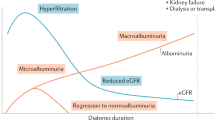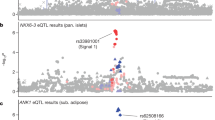Abstract
Type 2 or non-insulin-dependent diabetes mellitus (NIDDM) is the most common form of diabetes worldwide, affecting approximately 4% of the world's adult population. It is multifactorial in origin with both genetic and environmental factors contributing to its development. A genome-wide screen for type 2 diabetes genes carried out in Mexican Americans localized a susceptibility gene, designated NIDDM1, to chromosome 2. Here we describe the positional cloning of a gene located in the NIDDM1 region that shows association with type 2 diabetes in Mexican Americans and a Northern European population from the Botnia region of Finland. This putative diabetes-susceptibility gene encodes a ubiquitously expressed member of the calpain-like cysteine protease family, calpain-10 (CAPN10). This finding suggests a novel pathway that may contribute to the development of type 2 diabetes.
This is a preview of subscription content, access via your institution
Access options
Subscribe to this journal
Receive 12 print issues and online access
$209.00 per year
only $17.42 per issue
Buy this article
- Purchase on Springer Link
- Instant access to full article PDF
Prices may be subject to local taxes which are calculated during checkout






Similar content being viewed by others
Accession codes
Accessions
GenBank/EMBL/DDBJ
References
The Expert Committee on the Diagnosis and Classification of Diabetes ellitus. Report of the expert committee on the diagnosis and classification of diabetes mellitus. Diabetes Care 20, 1183–1197 (1997).
King, H., Aubert, R.E. & Herman, W.H. Global burden of diabetes, 1995–2025. Diabetes Care 21, 1414–1431 (1998).
Steiner, D.F., Tager, H.S., Nanjo, K., Chan, S.J. & Rubenstein, A.H. Familial syndromes of hyperproinsulinemia and hyperinsulinemia with mild diabetes. in The Metabolic and Molecular Bases of Inherited Disease (eds Scriver, C.R., Beaudet, A.L., Sly, W.S. & Valle, D.) 897–904 (McGraw-Hill, New York, 1995).
Taylor, S.I. Diabetes mellitus. in The Metabolic and Molecular Bases of Inherited Disease (eds Scriver, C.R., Beaudet, A.L., Sly, W.S. & Valle, D.) 843–896 (McGraw-Hill, New York, 1995).
Vionnet, N. et al. Nonsense mutation in the glucokinase gene causes early-onset non-insulin-dependent diabetes mellitus. Nature 356, 721–722 (1992).
Yamagata, K. et al. Mutations in the hepatocyte nuclear factor-1α gene in maturity-onset diabetes of the young (MODY3). Nature 384, 455–458 (1996).
Horikawa, Y. et al. Mutation in hepatocyte nuclear factor-1β gene (TCF2) associated with MODY. Nature Genet. 17, 384–385 (1997).
Yamagata, K. et al. Mutations in the hepatocyte nuclear factor-4α gene in maturity-onset diabetes of the young (MODY1). Nature 384, 458–460 (1996).
Stoffers, D.A., Ferrer, J., Clarke, W.L. & Habener, J.F. Early-onset type-II diabetes mellitus (MODY4) linked to IPF1. Nature Genet. 17, 138–139 (1997).
Malecki, M.T. et al. Mutations in NEUROD1 are associated with the development of type 2 diabetes mellitus. Nature Genet. 23, 323–328 (1999).
Maassen, J.A. & Kadowaki, T. Maternally inherited diabetes and deafness: a new diabetes subtype. Diabetologia 39, 375–382 (1996).
Concannon, P. et al. A second-generation screen of the human genome for susceptibility to insulin-dependent diabetes mellitus. Nature Genet. 19, 292–296 (1998).
Hanis, C.L. et al. A genome-wide search for human non-insulin-dependent (type 2) diabetes genes reveals a major susceptibility locus on chromosome 2. Nature Genet. 13, 161–166 (1996).
Duggirala, R. et al. Linkage of type 2 diabetes mellitus and age at onset to a location on chromosome 10q in Mexican Americans. Am. J. Hum. Genet. 64, 1127–1140 (1999).
Mahtani, M.M. et al. Mapping of a gene for type 2 diabetes associated with an insulin secretion defect by a genome scan in Finnish families. Nature Genet. 14, 90–94 (1996).
Hanson, R.L. et al. An autosomal genomic scan for loci linked to type II diabetes mellitus and body-mass index in Pima Indians. Am. J. Hum. Genet. 63, 1130–1138 (1998).
Elbein, S.C., Hoffman, M.D., Teng, K., Leppert, M.F. & Hasstedt, S.J. A genome-wide search for type 2 diabetes susceptibility genes in Utah Caucasians. Diabetes 48, 1175–1182 (1999).
Hani, E.H. et al. Mapping NIDDM susceptibility loci in French families: studies with markers in the region of NIDDM1 on chromosome 2q. Diabetes 46, 1225–1226 (1997).
Thomas, A.W. et al. Genetic linkage study of a major susceptibility locus (D2S125) in a British population of non-insulin dependent diabetic sib-pairs using a simple non-isotopic screening method. Hum. Genet. 101, 212–213 (1997).
Ciccarese, M. et al. Preliminary data on a genome search in NIDDM siblings: the NIDDM1 locus on chromosome 2 is not linked to NIDDM in the Sardinian population. Diabetologia 40, 1366–1367 (1997).
Ghosh, S. et al. A large sample of Finnish diabetic sib-pairs reveals no evidence for a non-insulin-dependent diabetes mellitus susceptibility locus at 2qter. J. Clin. Invest. 102, 704–709 (1998).
Cox, N.J. et al. Loci on chromosomes 2 (NIDDM1) and 15 interact to increase susceptibility to diabetes in Mexican Americans. Nature Genet. 21, 213–215 (1999).
Broman, K.W., Murray, J.C., Sheffield, V.C., White, R.L. & Weber, J.L. Comprehensive human genetic maps: individual and sex-specific variation in recombination. Am. J. Hum. Genet. 63, 861–869 (1998).
Braun, C., Engel, M., Theisinger, B., Welter, C. & Seifert, M. CAPN 8: Isolation of a new mouse calpain-isoenzyme. Biochem. Biophys. Res. Commun. 260, 671–675 (1999).
O'Dowd, B.F. et al. Discovery of three novel G-protein coupled receptor genes. Genomics 47, 310–313 (1998).
Cadel, S. et al. Aminopeptidase B from the rat testis is a bifunctional enzyme structurally related to leukotriene-A4 hydrolase. Proc. Natl Acad. Sci. USA 94, 2963–2968 (1997).
Khoury, M.J., Beaty, T.H. & Cohen, B.H. Fundamentals of Genetic Epidemiology (Oxford University Press, New York, 1993).
Saido, T., Sorimachi, H. & Suzuki, K. Calpain: new perspectives in molecular diversity and physiological-pathological involvement. FASEB J. 8, 814–822 (1994).
Carafoli, E. & Molinari, M. Calpain: a protease in search of a function. Biochem. Biophys. Res. Commun. 247, 193–203 (1998).
Dear, N., Matena, K., Vingron, M. & Boehm, T. A new subfamily of vertebrate calpains lacking a calmodulin-like domain: implications for calpain regulation and evolution. Genomics 45, 175–184 (1997).
Patel, Y.M. & Lane, D.M. Role of calpain in adipocyte differentiation. Proc. Natl Acad. Sci. USA 96, 1279–1285 (1999).
Smith, L.K., Rice, K.M. & Garner, C.W. The insulin-induced down-regulation of IRS-1 in 3T3-L1 adipocytes is mediated by a calcium-dependent thiol protease. Mol. Cell. Endocrinol. 122, 81–92 (1996).
Richard, I. et al. Mutations in the proteolytic enzyme calpain 3 cause limb-girdle muscular dystrophy type 2A. Cell 81, 27–40 (1995).
Barnes, T.M. & Hodgkin, J. The tra-3 sex determination gene of Caenorhabditis elegans encodes a member of the calpain regulatory protease family. EMBO J. 15, 4477–4484 (1996).
Delaney, S.J., Hayward, D.C., Barleben, F., Fischbach, K.-F. & Miklos, G.L.G. Molecular cloning and analysis of small optic lobes, a structural brain gene of Drosophila melanogaster. Proc. Natl Acad. Sci. USA 88, 7214–7218 (1991).
Blackwood, E.M. & Kadonaga, J.T. Going the distance: a current view of enhancer action. Science 281, 60–63 (1998).
Stam, L.F. & Laurie, C.C. Molecular dissection of a major gene effect on a quantitative trait: the level of alcohol dehydrogenase expression in Drosophila melanogaster. Genetics 144, 1559–1564 (1996).
Uitterlinden, A.G. et al. Relation of alleles of the collagen type Iα1 gene to bone density and the risk of osteoporotic fractures in postmenopausal women. N. Engl. J. Med. 338, 1016–1021 (1998).
Baier, L.J. et al. A calpain-10 gene polymorphism is associated with reduced muscle mRNA levels and insulin resistance. J. Clin. Invest. 106, R69–R73 (2000).
Naggert, J.K. et al. Hyperproinsulinaemia in obese fat/fat mice associated with a carboxypeptidase E mutation which reduces enzymatic activity. Nature Genet. 10, 135–141 (1995).
Jackson, R.S. et al. Obesity and impaired prohormone processing associated with mutations in the human prohormone convertase 1 gene. Nature Genet. 16, 303–306 (1997).
Flexner, C. HIV-protease inhibitors. N. Engl. J. Med. 338, 1281–1292 (1998).
Hanis, C.L., Hewett-Emmett, D., Bertin, T.K. & Schull, W.J. Origins of U.S. Hispanics: implications for diabetes. Diabetes Care 41, 618–627 (1991).
Groop, L. et al. Metabolic consequences of a family history of NIDDM (the Botnia study): evidence for sex-specific parental effects. Diabetes 45, 1585–1593 (1996).
MacLean, C.J. & Morton, N.E. Estimation of myriad haplotype frequencies. Genet. Epidemiol. 2, 263–272 (1985).
Lewontin, R.C. The interaction of selection and linkage. I. General considerations: heterotic models. Genetics 49, 49–67 (1964).
Boehnke, M. & Cox, N.J. Accurate inference of relationships in sib-pair linkage studies. Am. J. Hum. Genet. 61, 423–429 (1997).
Kruglyak, L., Daly, M.J., Reeve-Daly, M.P. & Lander, E.S. Parametric and nonparametric linkage analysis: a unified multipoint approach. Am. J. Hum. Genet. 58, 1347–1363 (1996).
Kong, A. & Cox, N.J. Allele-sharing models: LOD scores and accurate linkage tests. Am. J. Hum. Genet. 61, 1179–1188 (1997).
Andrews, N.C. & Faller, D.V. A rapid micropreparation technique for extraction of DNA-binding proteins from limiting numbers of mammalian cells. Nucleic Acids Res. 11, 2499 (1991).
Acknowledgements
We thank M.M. Le Beau for carrying out FISH analysis; A. Di Rienzo for sharing unpublished results of studies of the sequence of the NIDDM1 region in other racial and ethnic groups and in higher apes; M.S. McPeek and D.L. Nicolae for advice and assistance with the statistical analyses; A. Kong, B. Suarez, M. Boehnke and M. Lathrop for their comments on the manuscript; and E. Reyes-Gonzalez for providing the Zapoteca Indian samples. This work was supported by United States Public Health Service grants DK-20595, -42086, -47486, -47487, -47494 and -55889; the American Diabetes Association; the State of Texas; a grant from the Japanese Ministry of Health and Welfare for research on the human genome and gene therapy; an unrestricted grant for cardiovascular and metabolic research from Bristol-Myers Squibb; the Blum-Kovler Foundation; and the Howard Hughes Medical Institute. The studies from the Department of Endocrinology, University of Lund were supported by grants from the Sigrid Juselius Foundation, the Albert Påhlssons Foundation, the Swedish Medical Research Council, Medical Faculty of Lund University, Malmö University Hospital, the Ernhold Lundström Foundation, the Swedish Foundation for the Study of Diabetes, the Anna-Lisa and Sven-Eric Lundgren Foundation for Medical Research, Novo Nordic Foundation, the Juvenile Diabetes Foundation International and an EEC Grant BMH4-CT95-0662.
Author information
Authors and Affiliations
Corresponding author
Rights and permissions
About this article
Cite this article
Horikawa, Y., Oda, N., Cox, N. et al. Genetic variation in the gene encoding calpain-10 is associated with type 2 diabetes mellitus. Nat Genet 26, 163–175 (2000). https://doi.org/10.1038/79876
Received:
Accepted:
Issue Date:
DOI: https://doi.org/10.1038/79876
This article is cited by
-
Calpain activity is negatively regulated by a KCTD7–Cullin-3 complex via non-degradative ubiquitination
Cell Discovery (2023)
-
The inverse association between DNA gaps and HbA1c levels in type 2 diabetes mellitus
Scientific Reports (2023)
-
Association of CAPN10 haplotype combinations with type 2 diabetes mellitus and metabolic syndrome among Egyptians: pilot study—genotyping of three CAPN10 variants
Egyptian Journal of Medical Human Genetics (2022)
-
A brief insight into the etiology, genetics, and immunology of polycystic ovarian syndrome (PCOS)
Journal of Assisted Reproduction and Genetics (2022)
-
Association of vitamin D receptor gene polymorphisms with gestational diabetes mellitus-a case control study in Wuhan, China
BMC Pregnancy and Childbirth (2021)



